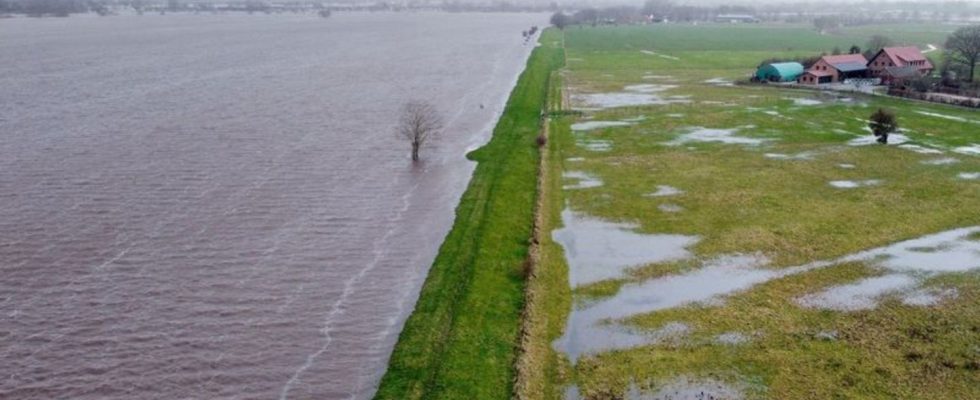storm
Flood situation: Fight against flooding and breathe a sigh of relief
A residential building on the dike on the Weser island of Hagen-Grinden (photo taken with a drone). photo
© Christof Dathe/dpa
Full reservoirs, weakened dikes and sandbag barriers: Some regions of Germany are still fighting the floods. In some countries, however, the situation is slowly easing.
The flood situation in Germany was inconsistent: in some places the situation calmed down, but elsewhere it is still critical, such as in Saxony and Saxony-Anhalt on the Elbe as well as in parts of Lower Saxony and North Rhine-Westphalia.
The flood situation, which is expected to be more relaxed for the time being, is unlikely to last. “With due consideration of the uncertainties, it must be stated that the risk of heavier precipitation is increasing significantly again,” said the meteorologist. “Especially in the west and northwest, the weather models indicate a lot of wet weather, which will probably cause river levels to rise quickly again.”
Climate change makes extreme weather events more likely. Potsdam climate researcher Stefan Rahmstorf wrote on
Tweet
What is the flood situation in individual federal states?
Saxony and Bavaria
In Saxony, the situation remains tense, especially on the Elbe. Water levels declined on other rivers such as the Mulde and the Weiße Elster. On the Elbe, the second highest alert level was 3 at the Schöna gauge on the border with the Czech Republic. In Dresden, the relevant water level of six meters had not yet been reached. The six-meter mark was predicted to be exceeded on Thursday morning. The city of Dresden had already declared alert level 3 on Tuesday evening.
According to the flood intelligence service, the flood situation in Bavaria continues to ease. On the Danube, when water levels fall, there are still small areas of flooding in reporting level 1, as stated in the management report.
Saxony-Anhalt
In parts of Saxony-Anhalt we can breathe a sigh of relief – but the water levels on the Elbe continue to rise. No local flooding is expected in the Mansfeld-Südharz district, where the Kelbra reservoir filled up after unusually heavy rainfall. The district announced this morning that no further evacuations would likely be necessary. The around 180 residents of the town of Thürungen had been advised to leave their homes the day before. The highest flood alert level 4 still applies to the Helme. According to the State Office for Flood Protection and Water Management, there is relief in the north of the country and in the Harz.
Thuringia
Individual residents of the town of Windehausen in northern Thuringia, which was evacuated due to flooding, can check on their houses and should open the cellars. Matthias Marquardt, mayor of the city of Heringen, to which Windehausen belongs, said this after discussions with a crisis team. The plan is for the residents of two streets in the town to first open their cellars so that pumping can begin there.
Lower Saxony
The flood situation in Lower Saxony remains tense. “The worst is over, but it is not over yet,” said a spokeswoman for the state agency for water management, coastal and nature conservation to the dpa. Water levels are expected to continue rising, especially on the Mittelweser and the upper reaches of the Aller, Leine and Oker. The city of Rinteln an der Weser has lifted the evacuation of a street due to the threat of flooding.
The flood also hit the Serengeti Park Hodenhagen hard: According to the park, large parts of the area north of Hanover are flooded and in some cases cannot be reached at all or can only be reached with Unimogs or tractors.
A herd of Heidschnucks was rescued from floodwaters in the Hanover region by boat. Emergency services from the German Life Saving Society (DLRG) brought the ten or so animals across the water in boats in Wedemark, north of Hanover, as the organization announced. On Boxing Day, the sheep were trapped by water from the Wietze River. The emergency services then took the animals individually in boats from a small piece of land where they had escaped.
North Rhine-Westphalia
The situation in North Rhine-Westphalia also remained tense. Despite local breaks in rain, numerous streams and rivers were still in flood. Even after Christmas, the Weser in the east of the country was most affected, as the North Rhine-Westphalia State Office for Nature, Environment and Consumer Protection announced.
Hesse and Rhineland-Palatinate
The water levels in Hesse continue to fall in many places. “With a general calming of the weather, the flood situation in Hesse is gradually easing slightly today,” said the Hessian State Office for Nature Conservation, Environment and Geology. On the Main, however, there is still a slight increase in water levels. The situation was similar in Rhineland-Palatinate: “Water levels are falling at the Upper Rhine gauges,” said the Rhineland-Palatinate flood forecasting center.
Bremen
According to the local fire department, a dike has burst in the municipality of Lilienthal near Bremen. The affected area is currently being evacuated by emergency services, the Lilienthal fire department announced on Facebook in the afternoon. Residents would be taken to an emergency shelter in a gym using a shuttle service. A tram line no longer runs due to its proximity to the operational area. There is a rail replacement service for them. The endangered area must not be entered.
According to the municipality of Lilienthal, one street is currently without gas and electricity supplies. Residents are advised to find a place to sleep with friends, relatives or acquaintances if possible. Emergency shelters should be used as a last resort. Lilienthal in the Osterholz district borders directly on the Bremen urban area. In Bremen, the flood situation in the Borgfeld district is similarly tense. Interior Senator Ulrich Mäurer (SPD) wants to see the situation there for himself on Thursday.

